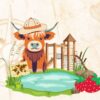Craigmill Den, Carnoustie
Situated just outside Carnoustie, Craigmill Den offers a quiet woodland walk with plenty for nature lovers to enjoy.
This area is a haven for wildlife and home to many species of birds, including Dippers, Grey Wagtails, Linnets, Tree Sparrows and Yellowhammers as well as more common garden birds such as Blackbird, Blue Tit, Chaffinch, Dunnock and Wren. In fact, more than 70 species of bird have been recorded in Craigmill Den.
On your walk through the den, you will pass the remains of a weir and then follow the Mill Lade, a channel that carried the swift current of water used to drive the mill wheel that was once part of Panbride Bleachfield.
We recommend your walk here is included as part of a longer route from Carnoustie or East Haven as parking is limited and the route through the den is relatively short.
When walking dogs in this area, please keep them on a short lead from 1 April to 31 July to protect the eggs and young of ground-nesting birds.



























